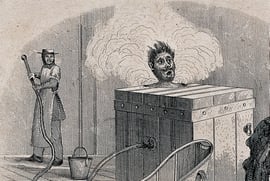I remember my first time visiting Lexington and Concord as a child. Even at that time I knew some of the stories about my ancestors in the American Revolution. One was my maternal fourth great-grandfather Capt. Jonathan Poor (1737-1807) of Newbury, Essex,..
Continue reading1897 map of Puerto Rico and the Virgin Islands, Matthews-Northrup Company (via Wikimedia Commons)
One “employment perk” at American Ancestors is a complementary consultation with one of our genealogists, and every now and then I get paired with a colleague for such..
Continue reading →Mural in Oswego, Kansas, depicting the Osage village of White Hair circa 1841 (via Wikimedia Commons)
Continue reading →At the turn of the twentieth century, Mary True Randall set up a photography studio with a dark room in her father’s house opposite Pittsford, Vermont’s Village Green. For almost 20 years, her camera captured children in formal poses and at play, quaint scenes of rural..
Continue reading →1863 print depicting American artist Washington Allston
I have lived in Allston, a neighborhood in Boston, Massachusetts, for about three years. For most of that time, I never gave the area’s name much thought. I assumed that it was either the name of a town back in..
Continue reading →Touro Synagogue from Patriots Park (Photo by author)
You might know Newport, Rhode Island, for its plethora of beautiful and historic mansions, many of which overlook the Atlantic coast. Maybe you know that the city hosted the first U.S. Open Tournaments for both..
Continue reading →Omaha Beach, 6 June 1944. By Robert F. Sargent
The world will pause today to remember the events in France which occurred eighty years ago during “Operation Overlord”—better remembered as D-Day. Many fine young men would not come home to their families from those..
Continue reading →Undated photo of Charles Anthony Stevens at home (in the family's collection)
In 1886, my great-grandfather Charles Anthony Stevens (1859–1932) opened a small retail shop in Chicago. At first, Chas. A. Stevens sold silk fabrics and notions to local women who made their..
Continue reading →Engraving of a man sitting in a steam box, May 1869. Source: Wellcome Images.
Have you ever wondered what non-surgical medicine was like in the nineteenth century? You may already be aware that the until the first use of ether in 1846, surgery was routinely performed..
Continue reading →








